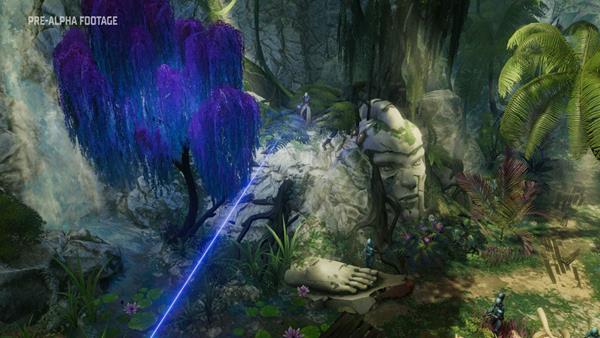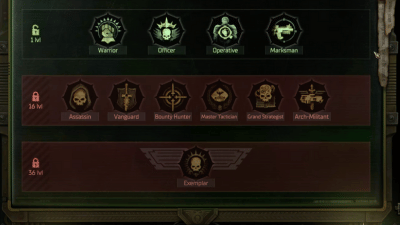Combat in Rogue Trader covers information about the mechanics of handling encounters with Enemies. Turn-based RPGs are very complex games, so players that have played any previous titles from Owlcat Games might find the combat mechanics similar and easy to catch. Gamers that are new to the title may have to bear having to learn about the dice throws, how the modifiers help the chances of success and the different type of actions that are available on each turn.
Rogue Trader Combat
Basics of Combat in Rogue Trader
The combat mechanics are inspired by the 2009 tabletop game from Fantasy Flight. The CRPG will have a turn-based combat style similar to Pathfinder: Kingmaker rather than real-time with a pause to take a bunch of combat decisions. The ruleset for combat mechanics won't be a complete adaptation but still, some elements will be taken from it. Combat is dependent on the outcome of dice rolls, d100 dices, depending on the resulting value plus modifiers that will decrease or increase the chance of success or failure in an event. For example, hitting an enemy from a distance with a weapon. These modifiers can be changed by gaining a status effect or granted as a passive effect from the character's Equipment.

Characters have Movement Points (MP), shown in green, and Action Points (AP), shown in yellow. You can see both in the middle of the UI panel. MPs are used for moving your character (1 MP for 1 tile, 1MP - every odd diagonal, and 2 MPs - every even diagonal). APs are used for various Abilities and Actions, as well as regular attacks. Normally, only one attack of any kind is allowed per turn, unless an ability states otherwise.
Projectiles can miss, hitting objects nearby or behind the target, including friendly targets. When shooting in volleys, highlighted tiles show the intended trajectory of the shots. AOE attacks like grenades or flamers always hit the selected tiles, but have a chance to do less damage.
You can fully dodge an attack - on a successful dodge roll, the attack will miss. Dodging an AOE attack will make your character literally step out of the affected tile.
Entering combat in Rogue Trader
Before starting a combat encounter, you will enter a phase where you can set up your characters in specific spots. This will greatly help you in planning your attack and strike strategically. All your characters will also immediately start rolling for Initiative, this determines the turn order in combat. This is calculated by your Agility and Perception bonuses, then divided by 2, and combined with a d10 roll. But even with this formula, it is important to keep in mind that there are also Enemies, and most of the time, you will encounter Enemies that outnumber your party. Even if some Enemies usually only take a couple of hits before they die, they can overwhelm you by their sheer number. It's best to plan out your attack and focus on taking out groups of enemies with AOE attacks.
Cover in Rogue Trader
Ground combat uses a cover system. When you hide behind cover, the shots have a chance to hit the cover instead, sometimes destroying it in the process. There are two types of cover: partial (shown as a half-empty shield) and full (shown as a full shield). Normally, a half cover will make an enemy reduce their hit chance by 35%. Having full cover reduces that chance by over 60%. When shooting from behind the cover, the character will step out, shoot, and then go back into cover. It is important to not leave some of your characters in the open and take full advantage of the hit chance reduction provided by covers.
Momentum Bar in Rogue Trader
Momentum is a special resource, representing the shifting flow of battle and opportunities arising in combat. The Momentum Bar is shown on the right side of your character portrait when it is their turn, and this can increase or decrease as you perform in combat. You gain it when you successfully hurt or kill enemies, and lose it when you spend it on abilities or when your characters get damaged or fall unconscious. This can lead your character to either do a heroic act when the bar is above 175 points or a desperate measure when below 25 points. These are the ultimate abilities that your characters will have access to, depending on how well they're doing in combat.
The Heroic Act or Desperate Measure abilities are associated with the class or Archetype of your character. Managing your momentum bar is an important aspect of combat, as you can take advantage of weak enemies and build your momentum bar up, and use the heroic act to wipe out the remaining enemies.
Veil Thickness in Rogue Trader
Opposite the Momentum Bar is Veil Thickness, this bar fills up when you use certain psychic Abilities in combat. When this bar fills up, you will have a chance to draw the Warp. The Warp is a chaotic reflection of the emotions experienced by psychic sensitive races. As Psykers use their abilities, the veil between this dangerous dimension and realspace is made thinner, after the bar reaches level 15, further use of major psychic powers may cause Perils of the Warp a random backlash effect. This meter will also increase if your enemies are using psychic abilities. You will have to manage your psychic usage during combat to not risk drawing more attention to yourself, as the warp can add a lot of disadvantage for your party during combat.
Rogue Trader Combat Bonuses
Characters get a bonus in melee if 2 or more characters are near the same target. Note that this doesn’t apply to large targets.
You can only attack with Melee Weapons or Pistols if the enemy is standing in the tile next to you. Note that trying to get away from an enemy may provoke Attacks of Opportunity and vice versa.
Switching Weapons doesn’t require MP or AP, but you can only parry or make attacks of opportunity if you have a Melee Weapon active.
Archetypes in Rogue Trader
Archetypes are development paths that your characters follow. Each Archetype encapsulates a unique set of skills and expertise and represents a specific combat specialization-- from the frontline warrior to the indispensable leader preferring to command from the rear. Archetypes in Warhammer 40K allows you to choose who you want to be in the grim dark future of Rogue Trader. Archetypes are divided into 3 categories: Basic, Advanced, and Exemplar.

At Level 1, players can choose from the 4 Basic Archetypes:
As players gain experience and explore the expanses, they will be able to progress and level up their Archetypes once they reach Level 16. They can now choose from the Advanced Archetypes before moving on to become an Exemplar at Level 36.

where can i learn about initiative?
0
+10
-1